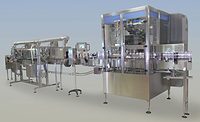Single-serve containers of wine are increasingly cropping up at retailers and finding their way into sports arenas, hotels and resorts, beaches and other venues. This trend has been accelerated by the commercial offering of pre-packaged wines that offer individual servings in “glasses” made of food-grade PET. These sealed, sterile and tamper-proof packages come filled with popular wine varietals.
There is a market for these beverages in places where disposed or broken glass could cause logistical or safety problems. Stack Wines, Anaheim, Calif., entered this market in 2013 with wines packaged in individual, sealed, un-stemmed plastic glasses. These containers are four-stacked into a tower around which a shrink-sleeve is placed to unitize the filled glasses into a single package.
In places where it would be unsafe or unseemly to dispose of glass containers, single-serve wines in recyclable plastic “glasses” are catching on. These might not appeal to the wine savants, but oenological sophistication doesn’t generally prevail at the venues in which these products will find their greatest demand.
Packaging challenges
Early in its product cycle, Stack Wines had to four-stack filled wine servings and place a shrink sleeve over each stack by hand. To meet growing demand, automation was required to package at higher speeds.
There are two steps to the shrink-labeling operation. First is the labeler, which applies shrink sleeves from rolls. The sleeved pack then passes through a steam tunnel, where the sleeve shrinks tightly around the stack.
Having considered their automation options, Stack Wines purchased equipment from PDC International Corp., a Norwalk, Conn.-based supplier of packaging machinery. Stack Wines selected PDC’s Model R-250 Evolution Shrink Labeler and Model KST 55-712 Single Zone Steam Tunnel. This equipment was installed at Varni Brothers of Modesto, Calif., a bottler of Dr Pepper Snapple Group’s 7-Up brand and other beverages. First, the stemless PET “glasses” are filled with wine and proprietarily sealed with a peel-back foil lid. The glasses then are automatically stacked four high and transferred to the shrink labeler, which processes as many as 90 stacks a minute.
Stack Wines Chief Executive Officer Matt Zimmer notes that he began his beverage career in the bottled water segment of the industry. “At that time, our fulfillment center was using a steam tunnel from PDC International to label our product,” he recalls.
When demand for Stack Wines reached a certain critical mass, Zimmer realized he needed to advance the operations. “[We] needed a higher level of automation to package and label our product,” he says. “We used a line-integrator to help us design the high-volume Stack Wines packaging/labeling system, and they steered us toward PDC International’s equipment. It has been working great for us.”
The shrink labeler
The R-250 Evolution Shrink Labeler is primarily mechanical in design and was engineered for continuous operation in packaging operations that run 24/7.
Recognizing that any shrink labeler that halts the cutting function adds to costly downtime, PDC designed durable blade systems. The company’s long-lasting and re-sharpenable blade assemblies deliver accurate, clean cuts on any sleeving film.
The shrink labeler also can integrate optional modules for vertical and horizontal perforations (important for consumer tamper evidence), date coding, and barcode verification. The standard sensor and verification package can be enhanced to identify jams, fallen bottles and other anomalies, and provide machine status information.
The steam shrink tunnel
Various types of shrink tunnels are used to shrink sleeve labels around the product containers, including infrared, convection and steam. Stack Wines opted for steam because of steam tunnels’ abilities to yield high-quality, uniform shrinking with graphics that are precise and distortion-free.
The PDC steam tunnel employs proprietary technology and design to apply heat uniformly and with great temperature precision because of its advanced steam control package while also metering steam for the lowest possible energy use, according to the company.
The package enables the product
It is not often that packaging and labeling techniques enable the creation of a new product, but such is the case with Stack Wines.
It’s hard to imagine what form the Stack Wines product would have taken without the confluence of technologies that enabled automated shrink-sleeve labeling to create a stack of individual wine servings.











